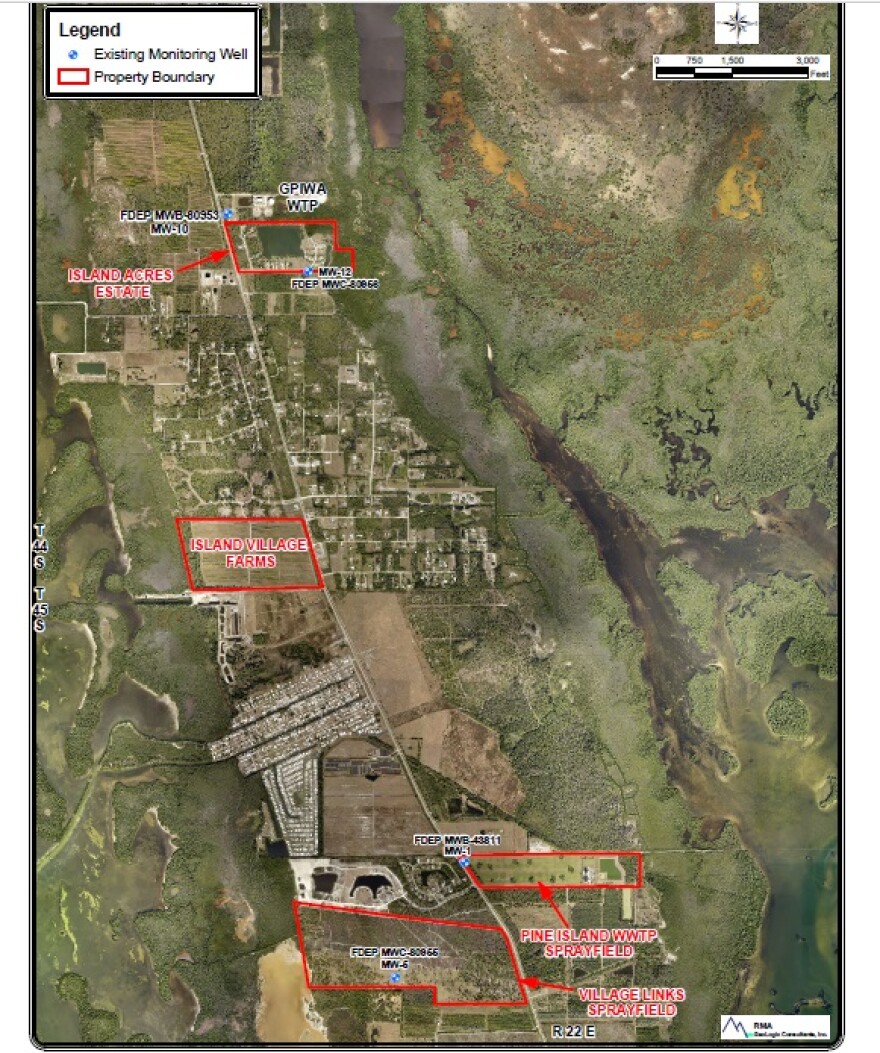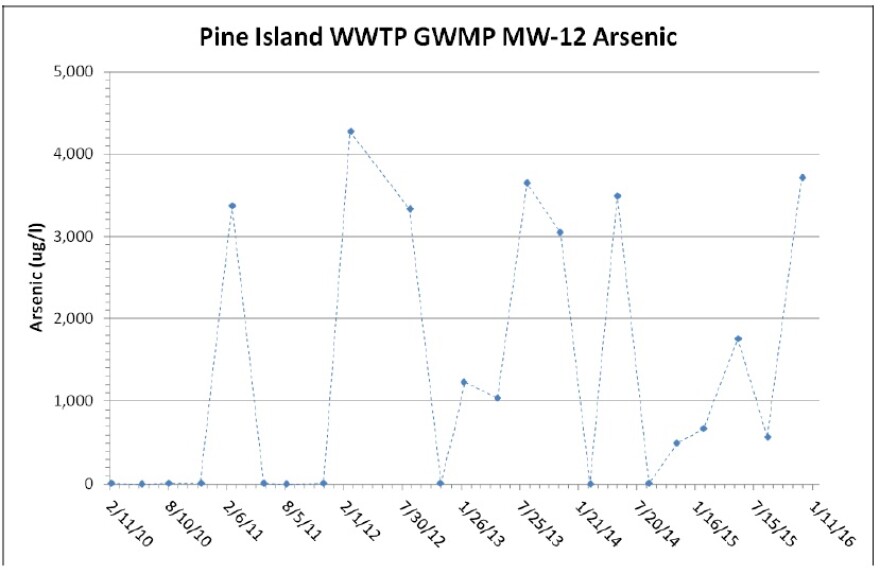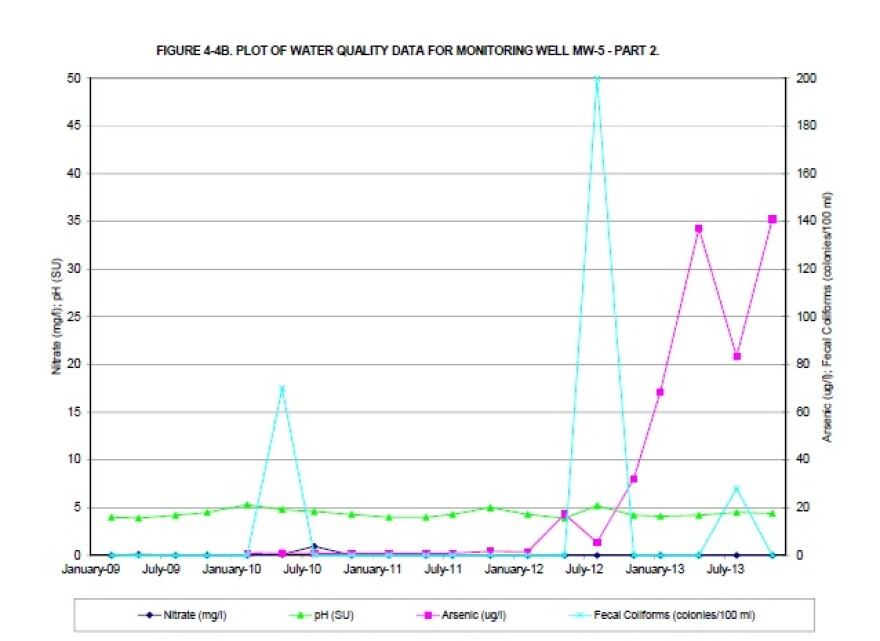UPDATED: Friday, June 30, 2017 at 10:36 AM
CORRECTION: WGCU originally wrote, "Acquaviva did not return WGCU’s calls for comment," but it should read "call."
Lee County is once again looking for the chemical arsenic on Pine Island. That’s after documents surfaced from a few years ago showing arsenic levels hundreds and sometimes thousands of times higher than the federal government allows on private and public lands.
Experts say this could’ve potentially harmed island residents and wildlife within the surrounding estuaries. Arsenic is a naturally occurring metal, but state and federal health officials say if high levels are consumed, it can make people sick and cause cancer.
Public records show state environmental officials knew about the high arsenic levels but decided to stop testing for it in 2015.
--
It's a windy day in Saint James City, on the southern tip of Pine Island. Bill Deile breaks up pieces of bread and throws them into the brackish lake behind his house.
“I’m feeding the turtles,” Deile said, laughingly.
He does this every day. Deile said he’s seen a lot of different creatures in and around the water like blue crabs, sheep’s head fish and alligators. There’s also a mixed group of shorebirds across the lake. And Deile said he sometimes sees an eagle.
“It's very rural, very agricultural,” Deile said about the Pine Island area. “People tend to do a lot of fishing and a lot of drinking. People are friendly. Everybody minds their own business.”
Deile has lived here in Island Acres Estate about a year and a half. He only recently found out dangerously high levels of the chemical arsenic were recorded on land in his neighborhood dating back to at least 2011.
Even higher levels of arsenic were detected on county-owned conservation land a couple miles away at Pine Island Flatwoods Preserve.
"What it means? I’m not sure," said Deile.

Local hydrogeologist Greg Rawl brought this information to light.
“When I first saw the levels, my first thought was ‘well, there's an error here,’” said Rawl.
But he said he later confirmed with county officials there was no error. Rawl is on the Conservation 2020 Committee that oversees the county’s purchasing and monitoring of preserved lands. During a committee meeting, he said he was surprised to find the Pine Island Wastewater Treatment Plant sprays its liquid waste onto the preserve, and in Bill Deile’s neighborhood.

“I was concerned about nutrient levels-- elevated levels of nitrogen and phosphorus,” said Rawl.
He said he was worried these nutrients were flowing into the two estuaries that surround Pine Island. Rawl did find nutrients, but he also found arsenic.
A state permit requires the county to test the groundwater through monitoring wells to make sure the spraying is not negatively affecting the land. So Rawl pulled up past reports Lee Utilities sent to the Florida Department of Environmental Protection from a DEP database. WGCU also acquired documents the DEP said it did not have. But the county had copies with a DEP date stamp on them.
“So when I started looking at the data, I was kinda blown away,” said Rawl.
The documents WGCU obtained show the highest level of arsenic reported by Lee County to the state was in 2013-- that number was 14,000 times higher than the U.S. Environmental Protection Agency allows in drinking water. And nearly 3,000 times higher than EPA standards for surface water bodies.
The EPA and DEP standards for drinking water do not allow arsenic to surpass 10 micrograms per liter, and their standards do not allow surface water bodies to go over 50 micrograms per liter. But Lee County reported to the DEP that the conservation land had the highest arsenic level at 141,000 micrograms per liter in 2013. And in 2012, the Island Acres Estate community well showed the highest arsenic level surpassing 4,000 micrograms per liter.

Dr. Ronald Gots is a private toxicologist in Martin County. He said these elevated levels of arsenic could harm people if they drank the arsenic-laden groundwater, or handled contaminated soil.
“That's not an amount that you would like to have in your drinking water because if you drank a liter a day of that, that could make you sick,” said Gots.
Lee County declined to do a recorded interview for this story, but a county spokesperson said in an email that Pine Island residents do not use groundwater wells for drinking. Even so, Doctor Gots said the soil in Bill Deile’s neighborhood should, at least, be tested.

Hydrogeologist Greg Rawl said there are a lot of unanswered questions about how this arsenic got onto the land. But he said the first thing that comes to his mind is…
“Illegal dumping. We have absolutely no proof of that, but to get these high levels, chances are would have to be some kind of waste product from some industrial use,” said Rawl.


Public documents show the county hired outside consultant Daniel Acquaviva sometime in 2014 to recommend what to do about the arsenic problem. His report blamed “cattle grazing operations” for the spikes in arsenic. Rawl said there are a few things wrong with this theory.
One: He said cattle do not generate arsenic. Cattle dipping sites do. They’re essentially holes in the ground filled with arsenic to dip the cattle and remove ticks. But the DEP’s website reports the only cattle dipping site somewhere on Pine Island was in 1933.
Below is a DEP list of recorded cattle dipping vats in the state. Lee County is on page 55 of the document.
Two: Cattle have been grazing on Pine Island Flatwoods Preserve since the early 2000's, so Rawl questions why arsenic levels would spike up all of a sudden in 2011. And three: Rawl said cattle grazing on the preserve does not explain why high levels of arsenic would also be detected at the Island Acres Estate neighborhood two miles away.
Conservation 2020 manager Cathy Olson backed up Rawl’s skepticism of cattle causing the high arsenic at a public committee meeting in March.
“We don’t really know where it came from... we just don’t know,” said Olson.
And Rawl said there’s something else wrong with consultant Daniel Acquaviva’s report. Rawl said his calculations are not right.
“The consultant used the numbers that I pulled offline with the one interesting exception… it didn't correspond to what the county had been submitting to the DEP for years,” Rawl said.
Rawl said the numbers Acquaviva used would have been right if he multiplied them by one thousand. Acquaviva did not return WGCU’s calls for comment.

Acquaviva's final report recommends the wells be closed. Then, based on his report, the DEP allowed Lee County to close those wells and open up new ones in 2015. Also, the DEP removed arsenic from the list of things to test for in the new wells.
The DEP declined to do a recorded interview, but in an email a spokesperson says the agency closed the wells and stopped testing for arsenic because it determined the chemical was not coming from the reuse spray water at the Pine Island Wastewater Treatment Plant. The spokesperson would not answer a question regarding whether the DEP was concerned about the environment or nearby estuaries.
But now after hydrogeologist Greg Rawl presented his concerns, the Conservation 2020 committee hired a company to open up three new wells near the previous ones on the Pine Island Flatwoods Preserve and started testing again for arsenic in February.
“So from a 2020 perspective, we've done what we're supposed to do, I think," said Rawl. "And ethically, I’ve informed the folks that appointed me to this position of the problems, so I’ve done what I can do.”

The first and latest report shows arsenic is present at only three times higher than federal drinking water standards—a significant difference from being thousands of times over in the recent past. So the committee decided not to attempt arsenic removal since they say it poses no threat to the people or the environment at this time.
But the Florida Department of Health’s website says “arsenic deposited on the ground from industrial or agricultural uses tends to stay in the top few feet of soil for a long time.” So that brings up a whole other question for Rawl: Where did the arsenic go?
“That kind of a rapid decrease would indicate that these really high levels of arsenic flushed out into the tidal waters very quickly,” said Rawl. “And based upon my knowledge of the area, groundwater doesn’t move that quickly.”
He said another possibility is something was done differently in the testing of these new wells than what was done in the past. The Conservation 2020 committee has a contract with the company Benchmark Enviroanalytical, Inc. to test quarterly for the next two years at a total cost of more than $30,000.
Back on Pine Island near Bill Deile’s lake, he said he wants to stay on top of the results going forward.
“I think the government has this duty to make people aware of things,” said Deile. “People by and large that live out here are very ecologically-oriented. There’s a lot of industry that depends on that, such as fishing. And people are very aware of the quality of the water, mostly the water in the Pine Island Sound and its estuaries, and the microcosm it has for birth and rebirth of the marine species that live there.”

After this investigation aired and was published, WGCU's call-in talk show Gulf Coast Live hosted a conversation to breakdown the story the same week. And the show's producers invited the DEP and Lee County to speak on the program. Both declined to appear on GCL, but county spokesman Timothy Engstrom emailed a response saying the numbers Lee Utilities reported to the DEP for years may have been wrong.
"Some of the data given to DEP by Lee County Utilities in past years may have been filed in the incorrect unit of measurement," said Engstrom. "Lee County is in the process of resubmitting the data collected to the DEP. It is possible some results may have been reported incorrectly higher than they actually were."
During WGCU's initial reporting of high arsenic on Pine Island, neither Lee County nor the DEP ever indicated to us that these quarterly reports could be wrong. And if the county had been wrongly reporting arsenic levels at thousands of times higher than is allowed by the state and federal government, that brings up yet another question: Why are Lee County and the DEP just now addressing the issue from years past?
DEP spokesperson Dee Ann Miller said in an emailed response to GCL producers that the agency is waiting for the revised Lee Utilities numbers. Miller also said that the monitoring well on Pine Island Flatwoods Preserve was no longer a good source for testing, which led to the well's closure in 2015.
"Because we saw elevated levels of other constituents for this well, such as fecal coliform, this also indicated a loss of integrity of the well itself," said Miller.
But that still does not explain the high levels of arsenic the county reported around the same time in the well two miles away in the private neighborhood of Island Acres Estate.
Check back for more updates.

















